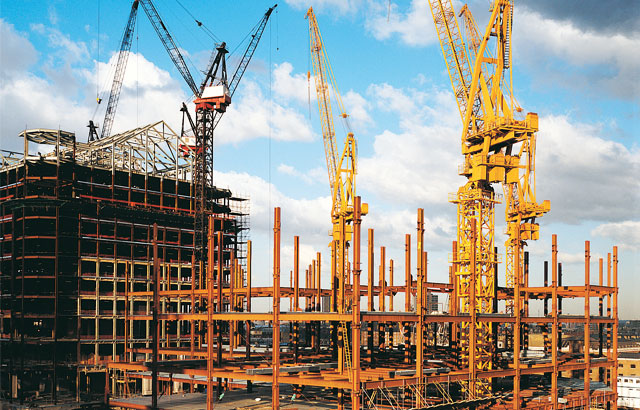Industry predictions: Our six thoughts on what is next for the construction industry in 2022

Ok, we’ll get the obvious question out of the way. Where has the year gone?
Without a doubt, it’s been one hit by constant disruption. Across Protrade, there’s probably no one more excited for the end of 2021 than our team of buyers. Kudos to those guys by the way. They have been excellent all year!
The industry’s news has been dominated by a mix of supply chain issues, rising material costs, and labour shortages. They’ve forced business, like ours and probably yours, to pivot and adapt like we haven’t before.
We’ve spoken before about how we have had to move away from some of our traditional methods – methods that have been part of our business for decades. We’ve learned on our feet and we’ve made decisions we haven’t had to before.
But, crucially, we’re ending the year in great shape and excited about what’s next for the industries we work within, particularly the trades and construction.
We referenced in an article we wrote earlier this year that construction won’t see a complete recovery back to pre-crisis 2019 levels until 2023. In line with that prediction, the past 12 months have been about finding our feet and now 2022 is going to be the year that construction begins to climb back to them.
So, let’s have it then! Our Managing Directors, Des Duddy and Craig Sanders, have given us their thoughts on what is in store for the industry in 2022…
1) Demand and price of raw materials will increase further
First things first, let’s start with what is happening over in the USA.
In November 2021, you may have heard that the US Senate passed a historic infrastructure bill. It’s worth eye-popping $1.2 trillion and centres on rebuilding the nation’s deteriorating roads and bridges and funding new climate resilience and broadband initiatives.
It’s a substantial bill. On the flip side, though, we’re expecting it will create a new wave of competition and demand for labour and raw materials – one that will even outweigh the problems that have been faced during 2021.
What we know is that the average price of raw materials has risen by an average of 20% during this year. We fully expect that figure will rise even higher in 2022 as factories and manufacturers producing raw materials and products turn their attention to this American bill because they know they can get money from the market, creating an attitude that no price is too high.
Our industry is operating in a seller’s market. That’s not going to change at all in 2022.
2) Off-site manufacturing will grow and thrive
Modern Methods of Construction – otherwise known as MMC – is one area of construction and manufacturing that has enjoyed accelerated growth, as a direct result not only of the COVID-19 pandemic, but also the supply issues we alluded to in the point above.
Earlier this year, we found that Savills, who you’ll know as one of the biggest retail estate agents in the UK, highlighted that the proportion of new homes built using MMC would increase from the current 6-10% to 20% of the market share in the coming years.
However, we believe that will need to increase further.
The housing crisis has been highlighted and discussed a lot recently and the UK has got a housing delivery target that has its back against the walls with projects being delayed (more on that later), as well as supply and labour issues.
For us, this is going to be a key area in which off-site manufacturing will grow and thrive.
Off-site techniques have progressed a great deal over the last few years. And yet, it still holds a sketchy reputation for its ability to create long-lasting and quality homes. This is a misrepresentation and we’re going to see that become the case more and more in our industry.
Remember the hospital that was built in Wuhan in 10 days or the 57-storey building erected in China in just 19 days? Expect to see far more examples of projects like these in the near future.
3) Delayed projects will return and start in 2022
We’re cheating slightly with this point as it’s directly associated with the first two points we raise.
We know there’s a battle right now for raw materials and as a result of that, off-site MMC will play a bigger part in housing developments moving forward, especially off the back of the Homes England programme, which is aiming to make a quarter of affordable homes from MMC.
In 2020 alone, it was estimated that over 4,500 construction projects were put on hold in the UK. Combined, those projects – made up mostly of housing schemes – were worth £70 billion. While we don’t have the latest data, the case has been the same during 2021.
While we don’t have the data, what we do know is that the construction industry is vital to the ongoing recovery of the wider UK economy.
Quite simply, those projects can’t afford to be on pause.
4) Vacated office spaces will make way for more residential renting
In our minds, there are a couple of reasons we should be expecting this.
Firstly, remote and hybrid working is the future of work. Millions of businesses are adopting flexible approaches, and are offering colleagues the opportunity to choose where they work.
The other reason, sadly, is because of the number of high street businesses that we have lost as a result of the pandemic and big change in customer shopping habits, with the UK seeing the biggest rise in vacant shops in over two decades late last year and the sharpest increase in empty offices since the financial crisis.
We expect the volume of these spaces will only increase as leases that large organisations hold come to an end. There will be a lot of empty office blocks all over the country so a big focus for 2022 is likely to be the refurbishment of those office blocks into residential communities to support the ongoing housing crisis.
5) EV will force a significant rethink in town planning
EV continues to dominate the agenda. You can’t watch TV without avoiding one advertisement for it or another. Here at Protrade, we’re revealed a few months back that we are in the process of shifting our entire fleet to EV, or at the very minimum hybrid. We have also installed electric charging points at our Derby headquarters and will be replicating that across our other depots.

That’s what is happening with our business – as well as others up and down the country. In reality, though, they’re small changes compared to what we’re going to see starting to happen in our town centres.
Let’s use an example. As I alluded to, off-site manufacturing has the capability to erect a 57-storey building up in 19 days. Sticking with that, if there are four apartments per floor, that’ll cater for a few hundred people.
As we edge closer towards EV becoming more prevalent, though, the question remains how those who own vehicles are going to be accommodated in our town centres and those living in the vicinity of them.
There’s a lot of people in the UK that are lucky to have off-road parking, but that isn’t the case for everyone, especially for those that live in built-up areas, close to city centres, where apartment blocks and rows of terraced houses are prevalent.
No one has yet to answer the question about how that issue will be navigated,. However, what we do see happening is towns being shaped around charging vehicles.
And with the Government’s legislation to end the sale of new petrol and diesel cars to end in the UK by 2030, there’s still a significant amount of infrastructure work that needs to take place.
6) Please resolve the UKCA Marking issue!
A prediction as well as hope!
For context, since leaving the EU, the UK has needed to start considering the latest quality standards and due to Brexit, the old CE mark manufacturers have used for years has been replaced by the new UKCA mark, which needs to be applied to goods placed into the UK market.
Using Protrade as an example, we import certain fasteners that require, by law, accredited performance criteria. Unfortunately, though, there is no UK test house currently in existence to carry out the necessary testing or conversion of current CE standards.
At this point, the Government has deferred obligatory UKCA marking until January 2023, although we believe a year may not be long enough to tick all the required boxes. The UK’s strict building standards are a good thing, as we can showcase the completion of numerous high-quality projects.
In order to continue meeting those standards, though, 2022 will be a busy year to pull all this together, in readiness for the January 2023 deadline. We’re keeping our fingers crossed that a solution is found.
Watch this space, as they say!
Do you agree with what our joint managing directors are saying? Do you have your own predictions for what is next for the construction industry in 2022? If so, we’d love to hear from you over on our social media channels!
Related Articles
- What the looming recession means for construction and how the industry leaders can respond
- New staggering MMC study is just another reason why it has become essential to the UK construction industry
- 2022 will be the ‘golden year’ for off-site manufacturing as construction becomes more efficient
- It’s time for sense and reason following the latest UKCA marking delay

Joint Managing Director, Protrade
Des has over 30 years of experience at Protrade, having worked in the capacity of Sales Co-ordinator, Account Manager, and product development, culminating in being appointed Joint Managing Director in 2018.



